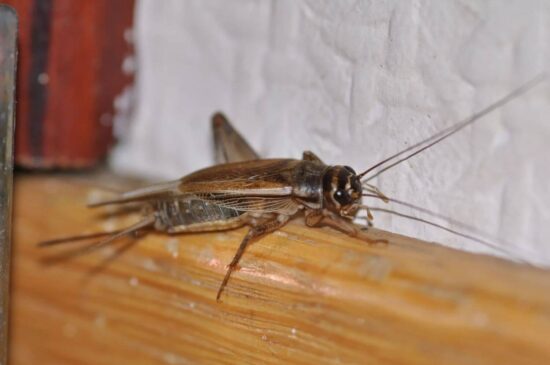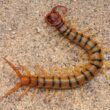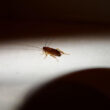Crickets might sound peaceful when chirping outside on a summer evening, but when they move into your home, they quickly become a nightmare. These little jumpers don’t just make noise all night long. They can also chew through your clothes, carpets, and even important papers. Plus, their waste can carry nasty bacteria like E. coli.
Crickets sneak into homes looking for three things: warmth, moisture, and food. Once they find a cozy spot, they can live indefinitely indoors and multiply fast. The good news? You don’t have to live with these unwanted roommates. Learning how to get rid of crickets effectively requires the right approach. Here are 15 proven methods that will show you exactly how to get rid of crickets and keep them out for good.
1. Set Up Simple Molasses Traps
This old-school trick works like magic and costs almost nothing. Crickets can’t resist the sweet smell of molasses, making it perfect bait for homemade traps. When you’re figuring out how to get rid of crickets naturally, molasses traps should be your first choice.
Mix 2 to 3 tablespoons of molasses with 2 cups of water in a shallow bowl or mason jar. The molasses acts like a magnet for crickets. They’ll jump toward the sweet scent, land in the water, and won’t be able to escape.
Place these traps in areas where you’ve heard crickets or seen them hopping around. Good spots include basements, kitchens, behind appliances, and near entry points like doors and windows. Check your traps every morning and empty them as needed.
The best part about molasses traps is they’re completely safe around kids and pets. You can leave them out without worrying about toxic chemicals. Just make sure to refresh the mixture every few days to keep it effective.
2. Use Sticky Traps and Glue Boards
Commercial sticky traps are one of the most effective ways to catch crickets without using harmful chemicals. These specially designed boards use strong adhesive that traps crickets the moment they step on them.
Popular brands like Catchmaster Cricket XL, Harris Cricket Traps, and MaxGuard make traps specifically for crickets. These aren’t your basic fly traps. They cover over 55 square inches and can be split in half for dual placement.
Place sticky traps along baseboards, in corners, near doors and windows, and anywhere you’ve spotted cricket activity. The traps work immediately and don’t need any bait. Many come with cricket-attracting patterns printed right on the adhesive.
Replace the traps when they’re full of bugs or every 90 days, whichever comes first. These traps are non-toxic and safe around children and pets, making them perfect for homes with little ones running around.
3. Apply Diatomaceous Earth Around Your Home
Diatomaceous earth (DE) might sound fancy, but it’s actually just a fine powder made from tiny fossilized sea creatures. This natural powder works like tiny glass shards that cut up cricket bodies, causing them to dry out and die.
Only use food-grade diatomaceous earth, not the kind made for swimming pools. Sprinkle a thin layer around baseboards, in wall cracks, and anywhere crickets like to hide. The powder is completely safe for people and pets but deadly for bugs.
Apply DE with a light hand. A little goes a long way, and too much powder can actually make it less effective. Focus on cracks between walls and floors, around appliances, and near entry points.
Reapply the powder every few days, especially after cleaning or if it gets wet. DE loses its effectiveness when damp, so keep it dry for best results.
4. Seal Entry Points and Create Physical Barriers
Crickets can squeeze through incredibly small spaces, so blocking their entry points is crucial for long-term control. Think of this as building a fortress around your home.
Start by walking around your house with a tube of caulk and some weatherstripping. Look for cracks in your foundation, gaps around windows and doors, and spaces where pipes or wires enter your home. Even tiny openings can let crickets inside.
Use caulk to fill small cracks and gaps. For larger openings, try expanding foam. Add weatherstripping around doors and windows that don’t seal tightly. Install door sweeps under exterior doors to eliminate the gap at the bottom.
Don’t forget about utility areas. Seal around air conditioning units, electrical boxes, and anywhere pipes enter your home. Cover vents with fine mesh screens that let air through but keep bugs out.
This method takes some time upfront but pays off big. Once you block their highways into your home, crickets will have to find somewhere else to live.
5. Make Essential Oil Repellents
Certain scents that smell great to people are absolutely horrible to crickets. Essential oils like peppermint, lavender, citronella, and eucalyptus work as natural cricket repellents.
Mix a few drops of essential oil with water in a spray bottle. Shake well and spray around entry points, windowsills, baseboards, and anywhere you’ve seen crickets. The strong scent overwhelms their senses and sends them packing.
You can also put a few drops of oil on cotton balls and place them in problem areas. This method lasts longer than spraying but covers a smaller area.
Reapply your essential oil treatments every few days to keep them effective. The scent fades over time, so regular reapplication is key.
Important note: If you have cats, skip the essential oils. Many oils can be harmful to cats, even in small amounts. Stick to other methods instead.
6. Control Your Outdoor Lighting
Crickets are like moths when it comes to light. They can’t resist bright bulbs, especially at night. Your outdoor lighting might be rolling out the red carpet for these unwanted guests.
Replace regular white outdoor lights with yellow “bug lights” or sodium vapor bulbs. These special bulbs are much less attractive to insects but still provide plenty of light for people.
Consider installing motion-sensor lights instead of keeping porch lights on all night. This cuts down on the time your lights attract crickets and other bugs.
If you need constant outdoor lighting, position the lights away from doors and windows. The farther your lights are from entry points, the less likely crickets will find their way inside.
Use timers to control when outdoor lights turn on and off. This reduces the total time your home is lit up like a beacon for bugs.
7. Remove Food and Water Sources
Crickets will set up camp wherever they can find easy meals and water. Cut off their supply chain, and they’ll move on to greener pastures.
Store all food in sealed containers, including pet food. Crickets will happily munch on dog kibble, cereal, fruits, and even crumbs on your counter. Clean up spills right away and don’t leave dirty dishes sitting around.
Fix any leaky pipes, faucets, or appliances. Crickets need water to survive, and even small drips can keep them happy. Check under sinks, around water heaters, and near washing machines for hidden leaks.
Use dehumidifiers in damp areas like basements and crawl spaces. Crickets love humidity, so drying out these areas makes your home less appealing.
Don’t leave pet water bowls out overnight if you can help it. Empty standing water from plant saucers, and make sure gutters drain properly away from your house.
8. Use Chemical Insecticides for Severe Problems
Sometimes natural methods aren’t enough, especially if you’re dealing with a large cricket invasion. Chemical insecticides can knock down big populations quickly when getting rid of crickets becomes urgent.
Pyrethroid-based sprays work well around windowsills, door frames, and other entry points. These chemicals disrupt cricket nervous systems and provide residual protection for weeks.
For outdoor treatment, granular insecticides can create a barrier around your home’s perimeter. Apply these products according to label directions, focusing on areas where crickets might approach your house.
Bait products like Niban combine attractants with poison. Crickets eat the bait and die, helping control populations both indoors and outdoors.
Always read and follow label instructions exactly. Keep children and pets away from treated areas until the product dries completely. Consider having professionals apply stronger chemicals if you’re uncomfortable doing it yourself.
9. Vacuum and Clean Thoroughly
Sometimes the simplest solutions work best. Regular vacuuming can remove crickets, their eggs, and the food sources that attract them.
Vacuum areas where you’ve seen crickets, paying special attention to corners, baseboards, and behind furniture. The suction will catch crickets that are hiding during the day.
Don’t forget about cricket eggs and shed skins in carpets and upholstery. These tiny remnants can lead to new infestations if left alone.
Empty your vacuum bag or canister outside right after cleaning. Crickets might still be alive inside, and you don’t want them crawling back out in your house.
Clean behind appliances, under furniture, and in storage areas where crickets like to hide. Remove clutter that provides hiding spots, and wipe down surfaces to eliminate food residue.
Regular cleaning also removes the scent trails crickets leave behind. These chemical signals help other crickets find good spots, so cleaning disrupts their communication network.
10. Modify Your Landscape and Yard
Your yard might be a cricket paradise without you knowing it. Simple changes to your outdoor space can make a huge difference in keeping crickets away from your home.
Keep your grass trimmed short. Tall grass provides perfect hiding spots for crickets during the day. Regular mowing eliminates this habitat and forces crickets to look elsewhere.
Move piles of firewood, mulch, and compost away from your house. Store firewood at least 20 feet from your home’s foundation. These organic materials attract crickets and give them easy access to your house.
Trim bushes and plants so they don’t touch your home’s exterior. Crickets use vegetation as highways to reach entry points. Creating a gap between plants and your house breaks this connection.
Fix drainage problems that create soggy areas in your yard. Crickets love moisture, so eliminating wet spots makes your property less attractive.
Remove piles of leaves, grass clippings, and other debris where crickets can hide. Keep your yard clean and well-maintained to reduce cricket habitat.
11. Plant Natural Cricket Repellents
Mother Nature provides some excellent cricket deterrents that you can grow right in your garden. These plants smell great to people but send crickets running.
Lavender is one of the best natural repellents. Plant it around your home’s foundation, near entry points, or in pots on your porch. The purple flowers look beautiful and contain compounds that crickets hate.
Peppermint, garlic, chives, and cilantro also work as natural barriers. These herbs serve double duty by repelling crickets while providing fresh ingredients for your kitchen.
Plant these repellent herbs and flowers in strategic locations around your home. Focus on areas near doors, windows, and other places where crickets might try to enter.
This method takes time to establish but provides long-term protection with minimal maintenance. Plus, you’ll have fresh herbs and beautiful flowers to enjoy.
12. Call Professional Pest Control Services
Sometimes cricket problems are too big to handle alone. Professional exterminators have access to stronger treatments and the experience to solve tough infestations.
Consider calling professionals if you’re seeing large numbers of crickets regularly, if DIY methods aren’t working after several weeks, or if crickets keep coming back despite your efforts. Professional exterminators know exactly how to get rid of crickets in even the toughest situations.
Professional cricket control typically costs between $175 and $325 for an average home. Many companies provide free inspections to assess your situation and recommend treatment options.
Professionals can identify exactly which type of crickets you’re dealing with and where they’re coming from. They’ll create a comprehensive treatment plan that addresses both current crickets and future prevention.
Many pest control companies provide eco-friendly treatment options if you prefer to avoid harsh chemicals. Ask about green alternatives when you call for quotes.
Quarterly maintenance programs can prevent cricket problems before they start. This ongoing protection is especially valuable if you live in an area with heavy cricket populations.
13. Install Physical Deterrents and Barriers
Beyond basic sealing, you can install specific devices and materials that make it nearly impossible for crickets to enter your home.
Use copper mesh around pipe penetrations. This flexible material fills irregular gaps perfectly and won’t rust or deteriorate like steel wool.
Install weatherproof door thresholds that eliminate gaps under exterior doors. These create a tight seal that stops crickets and other small pests.
Add window well covers to basement windows. These clear covers let light in but keep crickets and other pests out of vulnerable below-ground areas.
Screen all crawl space vents with fine mesh that allows airflow but blocks insect entry. Replace any torn or damaged screens immediately.
Check that garage doors seal properly against the concrete floor. Replace worn rubber seals that allow gaps where crickets can squeeze through.
These physical barriers provide permanent protection that doesn’t require ongoing maintenance or reapplication like sprays and baits.
14. Try Citrus-Based Natural Repellents
Crickets absolutely hate citrus smells, making oranges, lemons, and limes excellent natural deterrents. These fresh-smelling repellents are safe, pleasant, and effective.
Boil citrus peels in water to create a concentrated spray solution. Let the mixture cool, strain out the peels, and spray the liquid around entry points and problem areas.
Place fresh citrus peels near areas where you’ve seen crickets. Replace the peels every few days as they dry out and lose their scent.
Citrus essential oils work even better than fresh peels. Add a few drops to your regular cleaning solutions to repel crickets while you clean.
This method works great in combination with other treatments. The pleasant citrus scent won’t bother people but will definitely bother crickets.
15. Monitor and Maintain Your Cricket Prevention
Getting rid of crickets isn’t a one-time job. Successful cricket control requires ongoing attention and seasonal adjustments to stay ahead of these persistent pests. Learning how to get rid of crickets permanently means staying vigilant with your prevention efforts.
Conduct monthly inspections of your home’s exterior, looking for new cracks, gaps, or entry points that need sealing. Weather and settling can create new openings that crickets will find.
Keep detailed records of where you see crickets and when. This information helps you identify patterns and adjust your control methods for better results.
Check and replace sticky traps regularly, even if they don’t look full. Dust and debris can reduce their effectiveness over time.
Adjust your methods based on the season. Crickets are more active in warm weather and more likely to seek indoor shelter when temperatures drop.
Address moisture problems immediately. Fix leaks, improve ventilation, and use dehumidifiers to maintain conditions that crickets don’t like.
Review your outdoor lighting and landscaping periodically. Trim plants that have grown too close to your house, and replace any burned-out yellow bug lights with regular bulbs.
Conclusion
Crickets don’t have to take over your home and ruin your peace and quiet. With the right combination of methods, you can eliminate current cricket problems and prevent future infestations. Knowing how to get rid of crickets effectively makes all the difference in protecting your home.
Start with the safest, easiest methods like molasses traps and sticky boards. These work great for small problems and won’t expose your family to chemicals. Add physical barriers by sealing entry points and controlling moisture sources.
For bigger infestations, combine multiple methods for maximum effectiveness. Use essential oil repellents along with landscape modifications and professional-grade traps.
Don’t be afraid to call professionals if DIY methods aren’t solving your cricket problem. Sometimes expert help is worth the cost, especially for recurring infestations.
Remember that prevention is always easier than elimination. Regular maintenance and monitoring will keep cricket populations under control and protect your home year-round.
The key to success is persistence and using multiple methods together. Crickets are determined little creatures, but with the right approach, you can win the battle and enjoy cricket-free nights once again.


